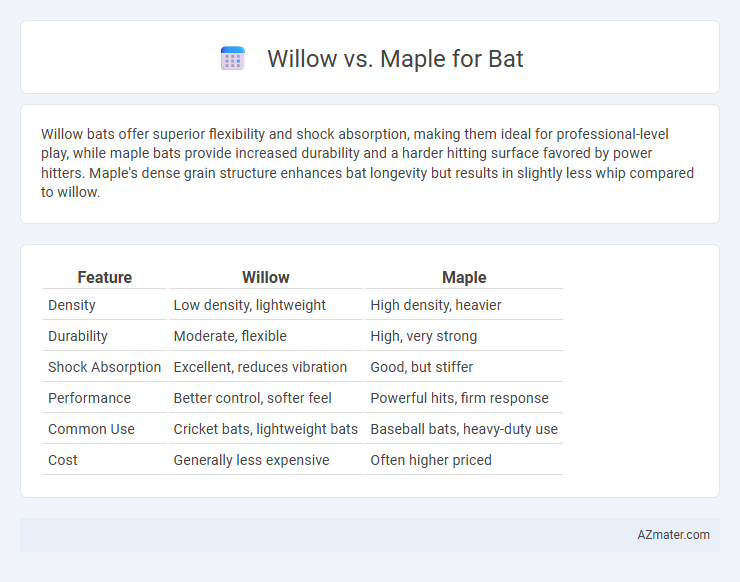Willow bats offer superior flexibility and shock absorption, making them ideal for professional-level play, while maple bats provide increased durability and a harder hitting surface favored by power hitters. Maple's dense grain structure enhances bat longevity but results in slightly less whip compared to willow.
Table of Comparison
| Feature | Willow | Maple |
|---|---|---|
| Density | Low density, lightweight | High density, heavier |
| Durability | Moderate, flexible | High, very strong |
| Shock Absorption | Excellent, reduces vibration | Good, but stiffer |
| Performance | Better control, softer feel | Powerful hits, firm response |
| Common Use | Cricket bats, lightweight bats | Baseball bats, heavy-duty use |
| Cost | Generally less expensive | Often higher priced |
Introduction to Willow and Maple Bats
Willow and maple bats differ significantly in materials and performance, with willow bats crafted from supple, lightweight wood ideal for professional players seeking excellent ball control and a larger sweet spot. Maple bats, made from dense, hard wood, offer greater durability and power, favored by hitters who prioritize strength and longevity in their equipment. Both types of bats have unique characteristics impacting swing speed, feel, and hitting style, making the choice dependent on player preference and playing level.
Wood Characteristics: Willow vs Maple
Willow wood is lightweight and has excellent shock absorption, making it ideal for bats that require quick swing speeds and durability. Maple wood is denser and harder, offering greater power and a solid feel but often resulting in a heavier bat. The choice between willow and maple depends on balancing speed and hardness for optimal performance in baseball or softball.
Durability and Strength Comparison
Willow bats offer superior shock absorption and flexibility, making them less prone to cracking but generally softer and less durable under high-impact hits compared to maple bats. Maple bats provide exceptional hardness and density, resulting in greater strength and durability, ideal for powerful hitters seeking longer-lasting performance. The choice depends on whether a player prioritizes durability and power (maple) or flexibility and reduced sting (willow).
Performance and Pop: Which Delivers More?
Willow bats, especially those made from sugar or white willow, are known for their exceptional performance due to superior flex and a lightweight feel, enabling faster swing speeds and better control. Maple bats, with their dense and hard grain structure, provide a louder pop and more power upon contact, which appeals to power hitters seeking maximum distance. When choosing between willow and maple, players prioritize willow for enhanced bat speed and precision, while maple is favored for its robust pop and durability during aggressive hitting.
Weight and Balance Differences
Willow bats are typically lighter, offering superior swing speed and better maneuverability compared to the heavier maple bats. Maple bats provide a denser weight distribution, resulting in a more balanced feel that enhances power and control during impact. Players seeking a lighter, faster swing often prefer willow, while those prioritizing strength and balanced weight lean towards maple.
Popularity among Professional Players
Maple bats are highly favored among professional baseball players for their superior hardness and durability, often preferred for powerful hits and longer lifespan. Willow bats, primarily used in cricket, showcase a lightweight structure and exceptional shock absorption, appealing to players seeking precise control and enhanced swing speed. In baseball, maple remains dominant due to its consistent performance in the major leagues, while willow sees niche use in specialized training or alternative bat designs.
Cost and Availability
Willow bats are generally more affordable and widely available due to the abundance of willow trees and efficient manufacturing processes. Maple bats tend to be pricier because of the denser wood and limited supply, which also affects their availability in certain markets. Players should consider budget constraints and local availability when choosing between willow and maple for their bats.
Maintenance and Longevity
Maple bats require less frequent maintenance due to their denser grain structure, making them more resistant to cracks and dents compared to willow bats. Willow bats, commonly used in professional cricket, offer superior flexibility but demand more careful upkeep to preserve their performance and extend their lifespan. Regular oiling and timely repairs enhance the durability of both willow and maple bats, with maple generally providing greater longevity under rigorous play conditions.
Environmental Impact of Wood Selection
Willow wood used for bats is more sustainable due to its rapid growth rate and lower environmental footprint compared to maple, which takes longer to mature and requires more extensive harvesting. Willow cultivation promotes soil conservation and demands less fertilizer and water, reducing ecological strain. Maple bats offer durability but their environmental impact is higher because of slower tree regeneration and more intensive resource use during processing.
Choosing the Right Bat: Willow or Maple?
Willow and maple bats offer distinct advantages based on performance needs and durability. Willow bats, favored in cricket, provide superior lightweight agility and excellent shock absorption, ideal for fast swing speeds and control. Maple bats, used primarily in baseball, deliver greater hardness and power with increased durability, suitable for strong hitters seeking maximum impact and longevity.

Infographic: Willow vs Maple for Bat
 azmater.com
azmater.com